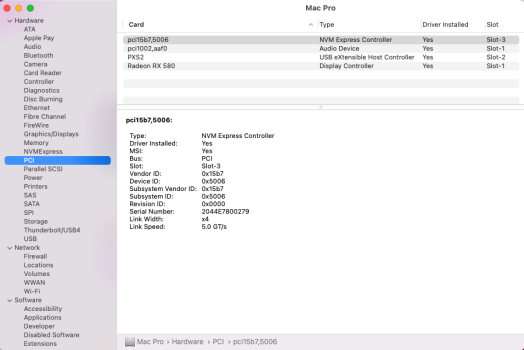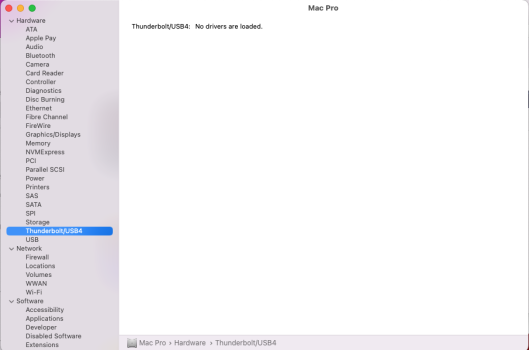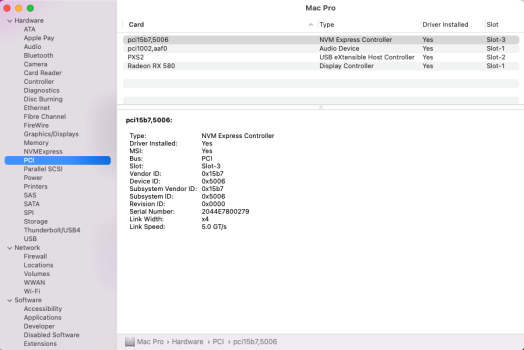Got a tip for us?
Let us know
Become a MacRumors Supporter for $50/year with no ads, ability to filter front page stories, and private forums.
MP 1,1-5,1 Manually Configured OpenCore on the Mac Pro
- Thread starter cdf
- WikiPost WikiPost
- Start date
- Sort by reaction score
You are using an out of date browser. It may not display this or other websites correctly.
You should upgrade or use an alternative browser.
You should upgrade or use an alternative browser.
- Status
- The first post of this thread is a WikiPost and can be edited by anyone with the appropiate permissions. Your edits will be public.
You can also use a programatic view of all required changes between 0.8.0 and 0.8.2, with Plistlib generator. In this case, AllowNvramReset and AllowToggleSip were removed from configuration, while certain software package versions were updated. If you have specific questions, feel free to ask them into support thread. cc @cdfWhat about if coming from 0.8.0? I think a few things need to be changed, huh?
Did you update by just going about it the normal way, as of it was a supported Mac? It’s my understanding that you can do this if you have some form of OC instslled with the appropriate patches etc.FWIW, I also use OCLP and upgraded from 11.6.7 to 12.4 and haven't noticed any issues at all so far. I updated 2 days ago. The main issue I have (which was also happening under 11.6.7) is that the computer doesn't wake from deep sleep by using the keyboard. I have to tap the power button to wake up the machine. Other than that, things have been good all around.
Yep, I just went to software update and chose to upgrade to 12.4. I let it do it's thing and it's running just fine. Actually, I'd say it's mostly running better. Now I just have to figure out how to getDid you update by just going about it the normal way, as of it was a supported Mac? It’s my understanding that you can do this if you have some form of OC instslled with the appropriate patches etc.
I asked over on the Titan Ridge thread but there doesn't seem to be a whole lot of action over there. And since it is OC related, hopefully someone here can answer this.
I installed OC on my MP 5,1 using OCLP. All of the how to videos I've found for installing a Titan Ridge Card are referencing Martin Lo's package instead. Are they interchangeable? I successfully flashed the card and it's installed, but not being recognized in the system report. I'm assuming this is an OC issue as I probably am missing drivers or some sort of extension.
Any suggestions on how to proceed? Should I just replace the OC directory on my EFI with the one from Clover Configurator? Is there a similar thing for OCLP that I need to add? Any help is very appreciated!
I installed OC on my MP 5,1 using OCLP. All of the how to videos I've found for installing a Titan Ridge Card are referencing Martin Lo's package instead. Are they interchangeable? I successfully flashed the card and it's installed, but not being recognized in the system report. I'm assuming this is an OC issue as I probably am missing drivers or some sort of extension.
Any suggestions on how to proceed? Should I just replace the OC directory on my EFI with the one from Clover Configurator? Is there a similar thing for OCLP that I need to add? Any help is very appreciated!
You should be able to keep your current setup and just include the required SSDT file for your card (it goes in the EFI/OC/ACPI directory). You can get an appropriate SSDT file from the main Thunderbolt AIC thread or from Martin's package.I asked over on the Titan Ridge thread but there doesn't seem to be a whole lot of action over there. And since it is OC related, hopefully someone here can answer this.
I installed OC on my MP 5,1 using OCLP. All of the how to videos I've found for installing a Titan Ridge Card are referencing Martin Lo's package instead. Are they interchangeable? I successfully flashed the card and it's installed, but not being recognized in the system report. I'm assuming this is an OC issue as I probably am missing drivers or some sort of extension.
Any suggestions on how to proceed? Should I just replace the OC directory on my EFI with the one from Clover Configurator? Is there a similar thing for OCLP that I need to add? Any help is very appreciated!
@cdf Thank You!! Ok, so I've added that SSDT file. is there anything I need to change or update? I did a cold restart and as you can see it still does not recognize the card...
Attachments
Last edited:
@cdf Thank You!! Ok, so I've added that SSDT file. is there anything I need to change or update?
Yes. You'll need to tell OC about the SSDT file:
Code:
<key>ACPI</key>
<dict>
<key>Add</key>
<array>
<dict>
<key>Comment</key>
<string>Table for Thunderbolt AIC</string>
<true/>
<key>Path</key>
<string>SSDT-TBOLT3.aml</string>
</dict>
</array>(Note that depending on your configuration, you may already have something in the array. In this case, just add the dictionary block below the existing ones. It's also possible for the array to be empty. In this case, replace
<array/> by the array block.)Yes. You'll need to tell OC about the SSDT file:
I'm guessing that goes in the config file?
Correct. You may want to take a look at the first post of this thread if you're interested in learning how to configure things manually.I'm guessing that goes in the config file?
I did, actually... but it's kind of above my pay grade! LOL. Some of it might as well be in Swahili as when it starts to get too technical, my brain has a kernel panic.You may want to take a look at the first post of this thread if you're interested in learning how to configure things manually.
I went ahead and put that into the config and still nothing.
I did connect a USB-3 SSD just to see if it was even getting power and it appears it is not... If it's not getting initialized/loaded during boot, shouldn't it still power an external ssd just from being plugged into the PCI slot?
Yes. And even without flashing the custom firmware or including the SSDT, you should get USB 3 functionality.I did connect a USB-3 SSD just to see if it was even getting power and it appears it is not... If it's not getting initialized/loaded during boot, shouldn't it still power an external ssd just from being plugged into the PCI slot?
Grrrr... So maybe the card is dead?Yes. And even without flashing the custom firmware or including the SSDT, you should get USB 3 functionality.
Should I be seeing it in the system report as being in slot 4 even if it's not loading the drivers? I'm going to try taking out the other USB card and see if that makes a difference... Otherwise, I'm guessing it's DOA.
Attachments
Yes, it should appear there. This can also happen with a bad flash.Grrrr... So maybe the card is dead?
Should I be seeing it in the system report as being in slot 4 even if it's not loading the drivers? I'm going to try taking out the other USB card and see if that makes a difference... Otherwise, I'm guessing it's DOA.
When I did the flash, I verified it and it came back good. Should I try flashing it again you think? That being said, it did not show up in the system report BEFORE I even flashed it so I don't think that would be the cause.Yes, it should appear there. This can also happen with a bad flash.
Last edited:
I would test with the original firmware flashed back just in case. If it still doesn't show up, then your card may very well be dead. (It might be a good idea now to continue any troubleshooting over on the Thunderbolt AIC card thread to avoid taking this thread off topic.)When I did the flash, I verified it and it came back good. Should I try flashing it again you think? That being said, it did not show up in the system report BEFORE I even flashed it so I don't think that would be the cause.
Last edited:
I was just thinking the same thing!(It might be a good idea now to continue any troubleshooting over on the Thunderbolt AIC card thread to avoid taking this thread off topic.)
There are some tweaks you can do to improve certain workflows, but it's something that is extremely specific to the workflow you are running like databases/CI/rendering and not OC related.@tsialex The over-provisioning settings you recommended for NVMe drives are working wonders on my system running OC 0.8+. The system used to produce fsck drive errors in a daemon over time that would have to be manually killed to free up memory. Nothing like that appears to have happened since and system remains snappier over extended use.
Are there any OC settings/tweaks that you or anyone would recommend for heavy resource usage users which would help keep the system running optimally over time; say, longer than 30+ days? Besides the obvious increasing RAM and changing the vm_compressor settings?
Heavy usage might include: multiple browser and application windows open over multiple desktop spaces running consistently. The system obviously slows depending on the number of windows opened and WindowServer is always the biggest culprit over time.
One thing that I learned over the years administering some colocated CI Mac minis/Pros, you should reboot with a certain frequency to avoid WindowServer and kernel_task gobbling too much RAM/CPU and to force the TRIM operation at start-up time. A lot of sysadmins do this automatically every two weeks, usually at the weekends.
Another one is that if you start to tweak to much, you'll certainly need some form of MDM (or at least a script) to re-apply the changes/tweaks you do after the SoftwareUpdates run, since some settings are changed back to default after the updates are applied.
So this doesn't work on anything pre Mojave. I restart with the option key. I get all of my different systems available to boot from, but if I pick any of them like say Yosemite, all O get is a black screen with a white circle with a line through it in the center. Is this possibly because of the RX580? would I need to swap out the GPU to run the older OSs?Bypass OpenCore by holding option key at boot (if you have a GPU with Mac bootscreen). Otherwise, use RefindPlus to bypass OpenCore, perhaps using MyBootMgr (search the forums).
It sounds something wrong to me.So this doesn't work on anything pre Mojave. I restart with the option key. I get all of my different systems available to boot from, but if I pick any of them like say Yosemite, all O get is a black screen with a white circle with a line through it in the center. Is this possibly because of the RX580? would I need to swap out the GPU to run the older OSs?
That “option boot” availability depends on the graphic card’s firmware. Without Mac EFI UGA, the cMP will hang. That’s why he said only use it with your graphic card has native boot screen on cMP. That has nothing to do with OSX version (OS not even started to load at that point).
If your RX580 isn’t flashed, “option boot” won’t work at all. I suspect you failed to use that option but, but still using the OC boot picker, then the board ID spoofing etc stopped Yosemite to load properly.
OpenCore does not see Legacy Windows. You need to use something like MyBootMGR to start it from RefindPlus.
thank you, i am gonna check this out ASAP<
what i noticed though is that i was no longer able to correctly install Windows 7 64bit<
whenever i would install Bootcamp drivers, afterwards it would give me bluescreen of blue tint, tried with different ISO, same result< made me wonder what happened, but did not investigate< could be connected to updated BootROM? probably not.
Ahhh. Gotcha. Thank you!If your RX580 isn’t flashed, “option boot” won’t work at all. I suspect you failed to use that option but, but still using the OC boot picker, then the board ID spoofing etc stopped Yosemite to load properly.
Wasn't so much that I failed as it was not really putting 2 + 2 together. Lol. Not much of a difference for the end result, but just know it was out of stupidity and not arrogance.
So I can put my stock GPU back in and then it should work? If I have both GPU's, will the presence of the RX580 stop it from booting even if there is a valid GPU also?
Depends on the GPU combination and which OS version.Ahhh. Gotcha. Thank you!
Wasn't so much that I failed as it was not really putting 2 + 2 together. Lol. Not much of a difference for the end result, but just know it was out of stupidity and not arrogance.
So I can put my stock GPU back in and then it should work? If I have both GPU's, will the presence of the RX580 stop it from booting even if there is a valid GPU also?
In most cases, OSX / macOS can work with multiple asymmetric GPU, but in some cases, the OS won't boot.
You have to try if that setup works for you.
If you want a more generic work around. You can install RefindPlus as your primary boot loader. Then further select OpenCore to boot newer OS, or boot to ancient OSX natively from there.
In this case, you can utilise RefindPlus's UEFI GOP boot screen. So that, no need to install the 2nd (original) GPU.
Thank you for the info! I'm not sure I understand all of it as I don't know anything about RefindPlus or the other one you mentioned BootManager(?) or something? Are there any how to posts on this for me to check out to see if it's something I could manage?Depends on the GPU combination and which OS version.
In most cases, OSX / macOS can work with multiple asymmetric GPU, but in some cases, the OS won't boot.
You have to try if that setup works for you.
If you want a more generic work around. You can install RefindPlus as your primary boot loader. Then further select OpenCore to boot newer OS, or boot to ancient OSX natively from there.
In this case, you can utilise RefindPlus's UEFI GOP boot screen. So that, no need to install the 2nd (original) GPU.
Register on MacRumors! This sidebar will go away, and you'll see fewer ads.




